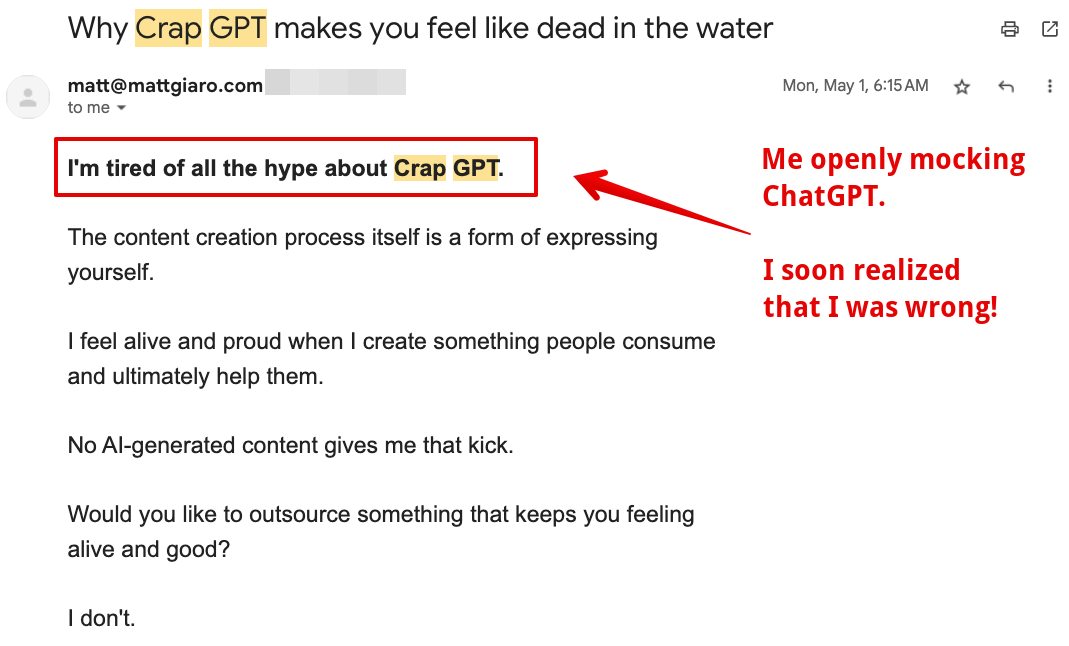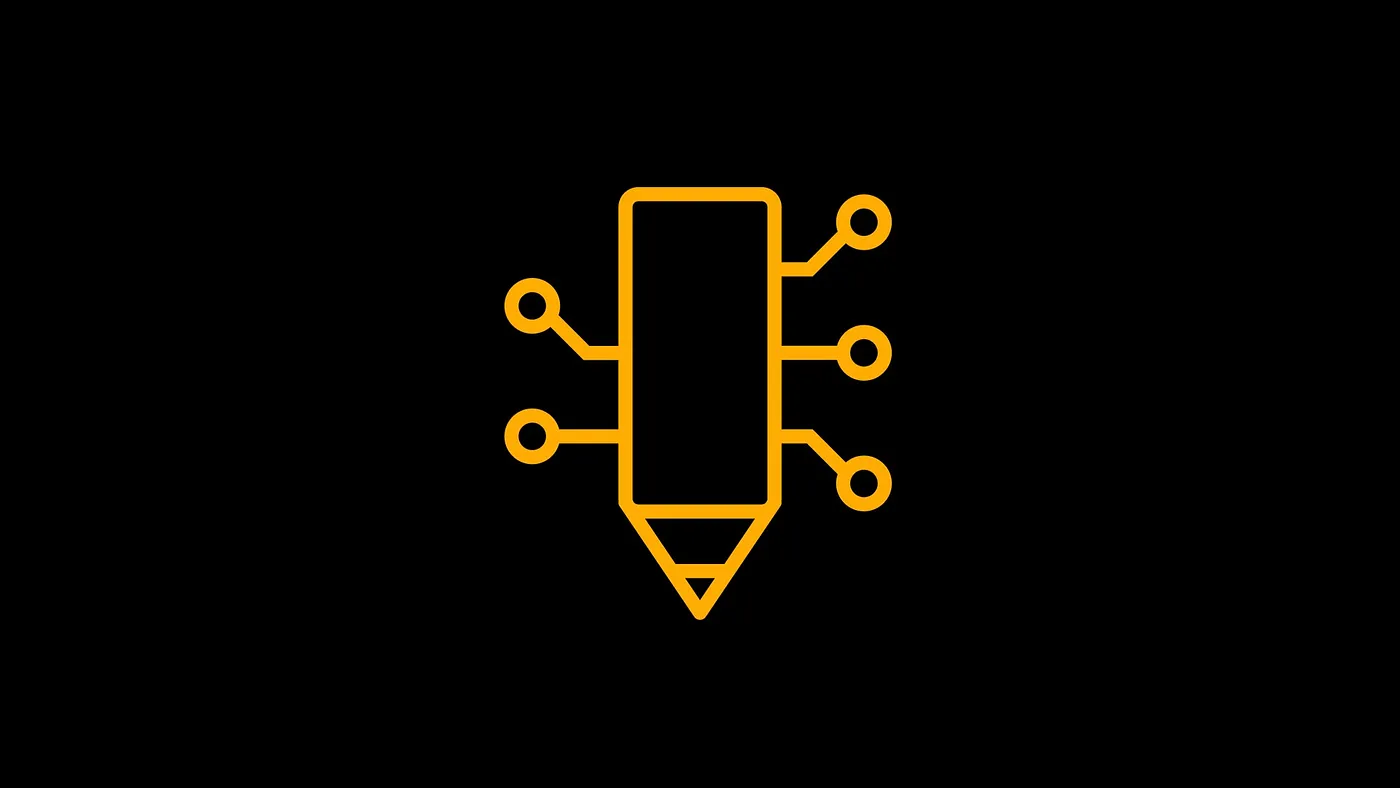Here’s The (Right) Way to Use Ai as a Writer
I laugh when I see writers say: “Do not write with AI! AI is garbage!”
And if that’s what you’re thinking, you’re damn wrong.
Before shouting and getting mad at me, wait a sec.
Because I thought that too. In fact, look at my Medium articles that I wrote shortly after ChatGPT came out. I even nicknamed it CrapGPT in some of my emails:

Today, AI helps me produce more content than ever — without having to through the pain of hiring anyone.
It made my content creation process smoother, fun, and more profitable.
And no, I’m not sounding like a robot.
Let’s see how AI could help you crank out more and better content 10x faster.
Writing more is stupid
Most entrepreneurs work more than 60 hours a week.
But the idea that you have to constantly work harder and grind away is total bullshit.
Back in 2013, Gary Vee was one of my gurus. I bought into the hustle porn cult. I worked my butt off in several different online businesses, thinking that if I just pushed myself harder, I’d finally reach the success I was chasing.
But you know what I got instead?
I burned out. I went through a painful divorce. And I broke my back. Literally.
Today, I still pay the consequences. I can’t sit at a computer for more than 2 hours straight without feeling the pain flare up.
Working harder often comes at other expenses — like your health, your family, or your sanity.
So the myth of writing more, harder, and longer makes no sense.
It’s derived from the stupid hustle culture. Wake up at 4 am. Take cold showers. Hit the gym at 4:30. Drink green juices, and squeeze in a yoga session between two meetings.
It’s a trap that leaves you burned out, broken, and bitter.
And for what? To prove that you can suffer for your craft?
There’s no glory in that, just a lot of unnecessary pain and sacrifice.
You don’t need to destroy yourself to create valuable content.
There’s no merit in masochism.
This is how the best thinkers wrote their books
Many writers are super picky about writing with AI because they have an overinflated ego and are maniacs.
Let me tell you this: No one cares if you write every single word yourself.
They care about your ideas, your insights, and your stories.
The value isn’t in you struggling or wrestling with your keyboard — it’s in the content you produce and the impact the content has.
Some of the most respected figures in history didn’t write their own books.
Ouch.
Think about ancient philosophers like Socrates. He didn’t put pen to paper; his disciples, like Plato, did that for him. Yet, no one questions the authenticity or value of those works.
The same goes for religious texts like what’s commonly known as the Bible, which was written by multiple authors over centuries.
Politicians, business leaders, and celebrities use ghostwriters to help shape their ideas into polished works.
It doesn’t make their thoughts any less valid or valuable. In fact, it’s often the best way to ensure their message is communicated effectively.
Take John F. Kennedy, for example. His Pulitzer Prize-winning book, Profiles in Courage, was largely written by his speechwriter, Ted Sorensen. Yet, it’s Kennedy’s name on the cover. But the ideas, stories, and values are his own.
Using a ghostwriter isn’t cheating — it’s common practice.
The reason why your AI-written stuff stinks like rotten fish
There are 100 million weekly users of ChatGPT as I’m writing this.
I’ll bet my right kidney that 90% don’t know how to use it to its fullest capacity.
Most people don’t know how to use AI effectively.
They think it’s a magic button that will instantly churn out perfect content with zero effort.
That couldn’t be further from the truth.
Using AI without giving it any context is like thinking that you can hire the best ghostwriter without having to provide him with any feedback on his work. That’s not how it works. Even the best ghostwriters need to sit down with you, extract some personal information, and get your feedback on what they’ve written.
AI is like a ghostwriter, but 100 times cheaper.
It’s here, 24/7, for 20 bucks a month.
The subtle advice that changed everything
When I first started using AI, I was disappointed.
The results were crap:
- Irrelevant ideas
- Disjointed sentences
- & a tone that didn’t match my style at all.
I thought, “Is this it? Is this what everyone’s raving about?”
So I ditched ChatGPT for a few months.
But then, one of my mentors pulled me aside and told me that AI is a trend I can’t afford to ignore.
So I pushed myself outside my comfort zone and dug into how AI works.
I spent over 100 hours learning, experimenting, and iterating on how to write better prompts.
The more I worked with it, the better I got at crafting prompts that gave me the results I wanted.
It wasn’t instant. It wasn’t push-of-a-button easy.
But the payoff was huge: I was now able to crank out SEO articles that captured my voice and my ideas and rank on the first page of Google. I was also able to write emails in 10 minutes or less.
I had the feeling that I just got an unfair advantage.
At that point, I felt guilty. Like I was cheating or taking the easy way out. But then something clicked.
I realized that AI isn’t here to replace my voice — it’s here to support it. With the right prompts and a bit of effort, I could get an 80% usable draft in a fraction of the time it used to take me.
That’s time I could spend refining my ideas, adding my personal touch, and even enjoying more off-time for my health and family.
So, if you’ve tried AI and felt like it didn’t work for you, don’t write it off just yet.
Learn how to use it to amplify your strengths and lighten your load.
AI took the burden off my shoulders, and it allowed me to focus on what really matters: delivering value to my audience.
The right way to write with Ai
So, how do you make AI work for you in a way that feels like it’s your own voice?
It’s all about the way you prompt it.
But I’m not talking about the stupid 101 prompts you can get on a social media giveaway or in a $2.99 ebook.
Here’s the process I’ve developed, and it’s made a world of difference in the quality of the output I get.
Step 1: Relate your writing voice
The first thing you want to do is feed AI some of your own writing. This helps AI understand how you write.
Whether it’s a blog post, an email, or even a long social media post, giving the AI a sample of your writing sets the foundation.
The reason why this is a better way to do things is because artificial intelligence works a bit like a human brain. It’s easier to reproduce an example than trying to wing it.
It’s like training it to understand you before it starts generating content.
Step 2: Prompt with your ideas
Once you’ve got that baseline, it’s time to prompt the AI with your ideas. And here’s where most people go wrong — they’ll say something like, “Write me an article about XYZ.”
Mistake.
Instead, give the AI a deeper sense of what you’re thinking.
For example, instead of just saying, “Write about topic XYZ,” you should tell the AI, “I want to write about XYZ. Here are the main points I want to cover, here are some personal stories that relate to the topic, and here’s my perspective on it.”
The more context and direction you provide, the better the content AI can generate for ya.
Step 3: Edit & improve
Now that you’ve set the stage, let the AI do its thing.
Because you’ve already given it a sample of your writing and outlined your thoughts clearly, the output you get is going to be 100 times better than the generic stuff you’d get from a five-word prompt.
It’s going to sound like you, think like you, and reflect your unique perspective.
But is it going to be perfect? Probably not.
As you’re reading through the content, you’re probably going to have more ideas or a different way to express things so here’s where the final touch comes into play.
This approach requires more work than simply copy-pasting a quick prompt, but the extra two minutes you spend crafting a detailed prompt will save you hours in the long run. You’ll end up with a first draft that’s 20 times faster to produce and far closer to what you actually want to say.
Don’t make the mistake of thinking that you can ignore AI. Ignore what the hustle-porn-writing-gurus are saying.
In a few years or months, they’ll bite their keyboard-burned fingers that they were totally wrong about it.
Want to learn how to write 10 times faster with AI? Click here to get my free course.

